Shooting Stars: Former Stars who played better elsewhere
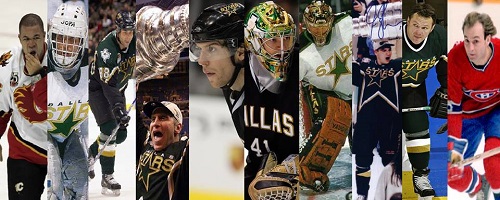
The Stars organization has had a great history, ranging from their start as the Minnesota North Stars in 1967, where they stayed until 1993 when they made their move to Dallas. There were several reasons the franchise made the move, most notably poor home game attendance after several losing seasons, an inability to reach new deals for a new arena, and a sexual harassment lawsuit with then owner Norman Green in which his wife threatened to leave him if he did not move the team.
Many big name players have been a part of this organization whether they played well for the Stars, played badly, or in the case of two players on this list, never played for the Stars at all. There are too many players to fit on this list, but I narrowed it down to ten that I felt would fit well on the list.

(Collage by Brendon Carlton)
Here are some of the many former Stars that played better or achieved more success on other teams in the NHL:
Jarome Iginla
That’s right, at one point in his career Jarome Iginla was a Dallas Star.
Unbeknownst to most Stars fans, Jarome Iginla was selected by the Dallas Stars as their first pick (11th overall) in the 1995 NHL Entry Draft. Iginla played that season in the WHL with the Kamloops Blazers. Before he even played a single game with the Stars, Jarome was traded to the Calgary Flames for Corey Millen and Joe Nieuwendyk (a player that almost made the list), who ended up as an integral part of the 1999 Stanley Cup victory for the Stars.
Iginla made his NHL debut with the Calgary Flames in the 1996 Stanley Cup playoffs, playing in two games in a series against the Chicago Blackhawks at the age of 18. He earned two points, scoring one goal and picking up an assist, and went on to be a top player in Calgary until he was traded to the Pittsburgh Penguins in 2013. He played only 13 regular season games and 15 playoff games as a Pen before later signing as a free agent to the Boston Bruins, for whom he currently plays.
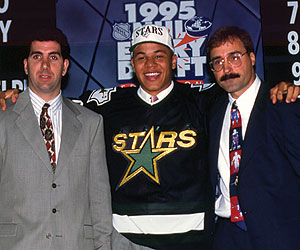
(stars.nhl.com/Dallas Stars)
Artūrs Irbe
Artūrs “The Wall” Irbe is well known as both well known in the NHL as a great goalie and one of the first players to come to the NHL from the Soviet Union in 1991. Irbe found himself a part of the Stars organization on two different occasions in the 1990’s, but did not play as well with the Stars as he did with other teams.
Artūrs Irbe was drafted by the Minnesota North Stars in the 10th round (196th overall) during the 1989 NHL Entry Draft, but wasn’t a part of the team long, as he was picked by the brand new San Jose Sharks in the 1991 NHL Expansion Draft, leaving the North Stars before he even played for them. Irbe played very well with the Sharks, making his NHL debut with them in 1991. Irbe helped lead the Sharks to their first playoff appearance in the 1993-1994, a series in which they eliminated the top seeded Detroit Red Wings in the first round, but was later eliminated in the next round by the Toronto Maple Leafs.
On July 22, 1996, The Wall found himself once again a part of the Stars organization, this time in Dallas, signing with them as a free agent. Artūrs was the backup goalie for Andy Moog during his one season stint with Dallas, playing 35 games and recording a win/loss record of 17-12-3. The 1996-1997 season was the only he played with the Stars, signing next season with the Vancouver Canucks and playing with the Carolina Hurricanes after one season as a Canuck.
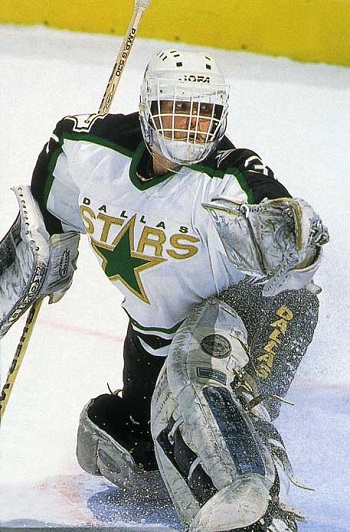
(neosaturn.com)
Eric Lindros
Eric “The Next One” Lindros is known by many as one of the best modern hockey players of all time, originally viewed as the Philadelphia Flyers‘ answer to the Pittsburgh Penguins‘ Mario Lemieux and the next Wayne Gretzky.
Lindros was selected first overall in the 1991 NHL Entry draft by the Quebec Nordiques (now the Colorado Avalanche), despite previously stating that he would not play for them. Lindros held out and the Nordiques refused to trade him until the NHL President at the time allegedly intervened to prevent the image of the league from being damaged. Eric Lindros was traded to the Flyers in 1992, a huge trade that brought players such as Peter Forsberg and Ron Hextall to the Nordiques.
Lindros made his NHL debut with the Philadelphia Flyers in the 1992-1993 season and ended up being one of the best players in the franchise history, serving as the captain from 1994 until he left the team in 2000. Lindros was a very large and physical player, who looked and played as if he were a defenseman, but had great offensive skills and was able to generate goals very well.
The Flyers traded Eric to the New York Rangers on August 20,2001, a team he played with for three seasons until he signed with the Maple Leafs in 2005. He played only one season with the Leafs until he signed with the Dallas Stars on July 17, 2006. Eric’s season with the Dallas Stars was less than impressive, only managing 5 goals and 21 assists during the regular season and not even a single playoff point.
Eric Lindros announced his retirement on November 8, 2007 at the age of 34.
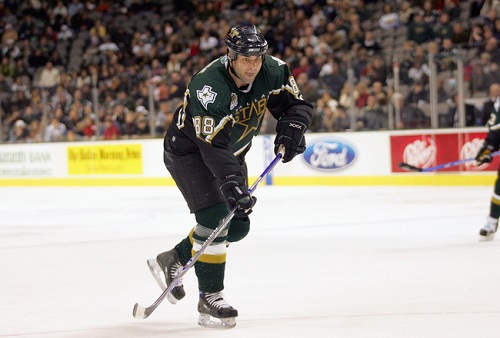
(Ronald Martinez/Getty Images)
Brett Hull
Any hockey fan who hasn’t been living under a rock for the last 30 years is sure to have heard the name Brett Hull before. Hull, nicknamed “The Golden Brett”, is one of those sensational players that doesn’t come around too often and just has a natural ability to score goals.
Brett Hull, son of legendary Bobby “the Golden Jet” Hull, came into the NHL as a part of the 1984 NHL Entry Draft, being selected in the 6th round (117th overall) by the Calgary Flames. Before coming into the NHL, Brett, also nicknamed “the Incredible Hull”, was viewed as a one-dimensional player, having a natural ability to score goals, but did not play very defensively. Brett only played one full season with the Calgary Flames before he was traded to the St. Louis Blues on March 7, 1988.
Hull’s move to the Blues marked the beginning of his prolific scoring and developed Brett as one of the top players in the NHL at the time. Brett played a total of 11 seasons with the Blues, with three consecutive seasons that he scored 70 goals or more, which led to the Blues eventually retiring his number (16) on December 5, 2006.
Hull refused a a new contract with the Blues at the end of the 1997-98 season, making him an unrestricted free agent. The Stars picked up Hull, who signed a 3-year, $17 million dollar contract on July 2, 1998, making him what many believe to be the final piece the Stars needed to win the Stanley Cup, which they did later that season thanks to Brett. Hull’s cup-winning goal against the Buffalo Sabres is quite possibly the most controversial goals in NHL history, with many Buffalo fans still claiming it should have been ruled “no goal”. The goal came in the 3rd OT with the game tied 1-1. Mike Modano got the puck from the corner and was soon surrounded by opposition, leading him to pass it to Jere Lehtinen, who quickly gave the puck to Hull, getting the puck past Sabres goaltender Dominik Hašek. Buffalo immediately contested the goal, stating that Hull scored the goal illegally while in the crease. The tape was reviewed, revealing that Hull’s skate was indeed int he goaltender’s crease, but was deemed to be a legal goal due to Hull receiving the puck before entering the crease, winning the first Stanley Cup for the Dallas Stars.
Hull played two more seasons with the Stars before signing with the Detroit Red Wings, where he played three seasons and won a second Stanley Cup. After the 2004-05 lockout, Brett signed with the Phoenix Coyotes where he played five games before retiring.
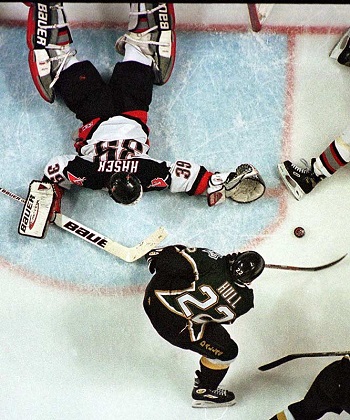
(Associated Press)
James Neal
James Neal has come to be one of the Pittsburgh Penguins’ top players after he was traded to them along with Matt Niskanen in exchange for Alex Goligoski, leaving many Stars fans upset that Dallas let him go before he reached his potential.
James Neal was selected by the Dallas Stars in the 2005 NHL Draft in the second round (33rd overall). Neal played two more seasons as a junior with the Plymouth Whalers before the Stars brought him up to the Iowa Stars for the 2007-08 season, where he recorded 18 goals and 19 assists in 62 games. He made his NHL debut the next season and played well, recording 24 goals and 13 assists. Neal played one and a half more seasons as a Dallas Star before he was traded to the Pens on February 21, 2011. James struggled to get used to the new team for the rest of the season, only scoring one goal and 5 assists in 20 games, leading many Stars fans to think we had gotten the better end of the deal, but Neal proved the next season that was far from true as he exploded offensively recording 40 goals and 41 assists for a total of 81 points. James Neal remains to be one of Pittsburgh’s top offensive players alongside people like Sidney Crosby and Evgeni Malkin, which has left a sour taste in the mouths of many Stars fans.
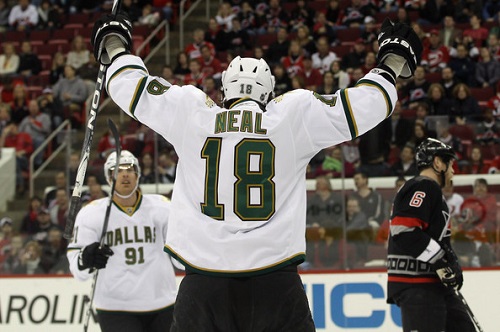
(Bruce Bennett/Getty Images North America)
Mike Smith
Mike Smith is a goaltender that the Stars never quite viewed as head goalie material, playing only as the backup goaltender for Marty Turco.
Mike Smith entered the league in the 2001 NHL Entry Draft, being picked by the Dallas Stars in the 5th round (161st overall). Smith spent the next six seasons playing in the OHL, ECHL, and AHL before the Stars finally brought him up for the 2006-2007 season to be Marty Turco’s backup. Smith played well both seasons, winning most of the games he played, but it was not enough to gain any serious attention from the Stars organization, spending both seasons in the shadow of veteran Star goalie, Marty Turco, which whom Smith briefly lived with in 2007. Smith was traded to the Tampa Bay Lightning on February 26, 2008 along with Jussi Jokinen, Jeff Halpern, and a 2009 4th round draft pick, the trade that brought Brad Richards (a player that almost made this list) and Johan Holmqvist. Smith played two more seasons with the Lighting before signing a two-year contract with the Phoenix Coyotes, reuiniting him with former Dallas Stars coach, Dave Tippett.
In the past few seasons with the Phoenix Coyotes, Mike Smith has become one of the top goaltenders in the league and making some Stars fans wish he was a still part of the team. On October 19, 2013 Smith even became the 7th goaltender in NHL history to be credited with scoring a goal with a shot made himself, shooting the puck all the wasy across the ice and scoring with 0.1 seconds left against the Red Wings, which was the icing on the cake for many Stars fans.
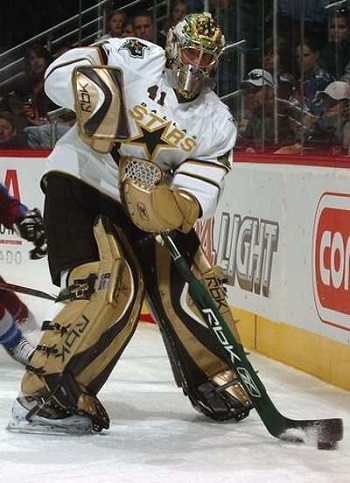
(Yahoo Sports)
Andy Moog
Andy Moog played as the Dallas Stars head goaltender for four seasons in the 90’s, but is best known as the goaltender who played alongside Grant Fuhr on the Edmonton Oilers in the 80’s, playing a big part in getting them to their first Stanley Cup Finals and also winning the cup the next season.
Moog was drafted by the Edmonton Oilers in the 1980 NHL Entry Draft in the 7th round (132nd overall). He didn’t receive any serious playing time until the 1982-83 season when GM/Head Coach Glen Slather chose to use the young goaltending duo of Moog and Grant Fuhr. The Oilers made it to the playoffs, where Moog was given the starting spot and led his team (featuring players such as Wayne Gretzky, Mark Messier, and Jari Kurri) to their first Stanley Cup Finals, where they were swept in a disappointing series against the New York Islanders (winning their fourth in a row). The Oilers returned to the playoffs the next year and Fuhr was chosen as the starting goalie. Fuhr led the Oilers to the final, but was injured in the third game of the finals, once again against the Islanders, prompting Moog to take his place. Moog played well enough for his team to win the series and the first cup for the Edmonton Oilers.
Fuhr continued to be Edmonton’s top choice for several seasons, leading to Moog demanding a trade, which he got at the trade deadline of the 1987-88 season to the Boston Bruins. Andy played six seasons with the Bruins before he was traded to the Minnesota North Stars just as they were making their move to Dallas. Moog’s play with Dallas was good, but nothing too impressive, garnering even less attention when the Stars acquired Eddie “The Eagle” Belfour. Moog signed as a free agent with the Montreal Canadiens for the 1997-98 season, which would be his last before retiring.
After his playing career Andy Moog came back to the Dallas Stars organization, playing several roles such as player development coach, goaltending consultant and coach, as well as being the Assistant Coach until July 1, 2010 when his contract expired and he was not offered an extension.
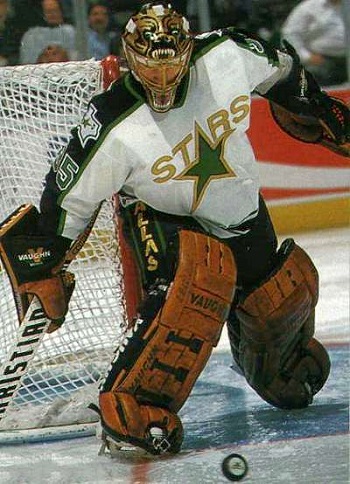
(Neutral Zone Hockey)
Jamie Langenbrunner
Jamie Langenbrunner is one of the two players on this list, along with Brett Hull, who played a big role in the 1999 Dallas Stars Stanley Cup victory, but seemed to play better while on other teams. In Hull’s case, his best playing was before he joined the Stars while still on the St. Louis Blues, but in the case of Jamie Langenbrunner, he was traded by the Stars before reaching his full potential.
Jamie Langenbrunner was chosen by the newly relocated Dallas Stars in the 1993 NHL Entry Draft in the second round (35th overall) at the ripe young age of 18 years old, choosing not to play his senior year of high school hockey, instead choosing to play the next two seasons in the OHL with the Petersborough Petes, tallying an impressive 75 goals and 115 assists in 124 games. It was in his second season with the Petes that Jamie made his NHL debut with the Stars on April 9, 1995 against the St. Louis Blues. Langenbrunner played the 1995-96 season with the Michigan K-Wings, occasionally being called up to the Stars, but he began his rookie season as a regular member of the Stars the next year. Jamie had a great rookie season impressing many and even becoming a finalist for the Calder Memorial Trophy (which went to Bryan Berard of the Islanders).
Langenbrunner proved to be a top player over the course of the next few seasons, being the third highest scorer for the Stars in the 1998-99 Stanley Cup season, right behind Stars hero Mike Modano and Conn Smythe Trophy winner of that year, Joe Nieuwendyk. Jamie recorded 10 goals and 7 assists in the offseason that year, playing a big part offensively and helping his team win the first cup of it’s franchise.
Jamie was traded on March 19, 2002 along with Joe Nieuwendyk to the New Jersey Devils (the team that beat the Stars in their 2000 return to the Stanley Cup finals) in exchange for Randy McKay and (an honorable mention for this list) Jason Arnott. Jamie’s time with the Devils was when he blossomed into a leader and greater offensive player, becoming the NHL’s top Stanley Cup Playoff Scorign Champion in 2003, leading his team, along with Joe Nieuwendyk, to his second Stanley Cup Championship, the third in New Jersey franchise history.
After playing a total of eight full seasons with the Devils, serving as the captain from 2007 to 2011, Jamie was traded back to Dallas halfway through the season for a conditional third-round pick in the 2011 NHL Draft. This trade saw Jamie playing his 1,000th game in his first game back on the Stars, even scoring a goal in his return. His return didn’t last long, seeing him become a free agent and heading to the Blues for the next season. He played only 4 games in the lockout shortened 2012-13 season before undergoing a season-ending surgery in his left hip, spurring from an ongoing torn labrum.
Jamie Langenbrunner is currently a free agent, not signed to a team, although he has expressed interests in playing with the Minnesota Wild.
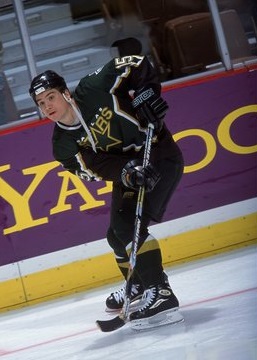
(Jeff Gross/Getty Images)
Claude Lemieux
Claude Lemieux was often known throughout his career in the NHL as a pesky player and one of the most reviled, dirtiest, and most hated players in the NHL. Along with that reputation, Claude was known in the peak of his career to be a player that could put up 20-40 goals in a season and just as many assists.
Lemieux was drafted in the second round (26th overall) of the 1983 NHL Entry Draft by the Montreal Canadiens. While playing in Montreal, Lemieux picked up his first Stanley Cup win in 1986 before being traded to New Jersey in 1990. Stanley Cup success was just around the corner once again for young Claude, winning his second with the New Jersey Devils in 1995. Lemieux was traded to Colorado during that next offseason, just in time for their 1995-96 Stanley Cup win, making it his third, also making him one of only ten players in NHL history to win the cup with three different teams, but this was not his last taste of Stanley Cup success. Lemieux found himself being sent back to New Jersey in 1999, playing with the Devils to defeat his future team and defending champions, the Dallas Stars, winning the 2000 Stanley Cup, his fourth and final.
It was in the following seasons that Claude’s playing waned more and more only scoring 2 goals and 4 assists with the Dallas Stars when the acquired him from the Phoenix Coyotes. It was after this season that Claude chose to end his career, retiring as a Dallas Star. Lemieux came out of retirement in 2008, playing 18 games with the Sharks and only recording one point before returning to retirement.
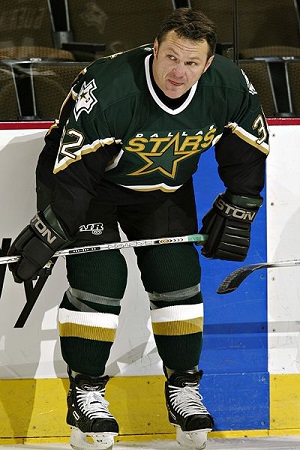
(Getty images/NHLI)
Guy Lafleur
Seeing the name Guy Lafleur on a list like this probably has many people scratching their heads, but he was indeed a part of the Stars organization at one point. Like Jarome Iginla, Lafleur never played a game with the Stars, and is on this list due to a technicality and out of interesting terms.
Guy Lafleur is quite possibly one of the best hockey players to ever play in the NHL, being the first to score 50 goals and 100 assists in six straight seasons, winning five Stanley Cup Championships with the Montreal Canadiens, a team that he remained with from 1971 until his first retirement in 1985 after being drafted first overall in the 1971 NHL Entry Draft. Guy developed a smooth skating style and knack for scoring goals, making him one of the most popular players on the team, even having fans chanting his name every time he touched the puck. In the early 80’s Guy started having conflicts with then coach, Jacques Lemaire, who wanted players to be more defensive, whereas Lafleur was more offensive minded. Guy retired during the 1984-85 season after playing only 19 games and recording only 2 goals and 3 assists.
The retirement was short lived when Lafleur made his return to the NHL in 1988 after being inducted into the Hockey Hall of Fame, playing one season with the New York Rangers and two with the Quebec Nordiques. It was in the 1991 Expansion Draft that Lafleur found himself a part of the Stars organization as the Minnesota North Stars used their 20th and final pick to draft Lafleur, despite knowing that he was retiring that year. Lafleur was only with the North Stars for a day, having already accepted an office job with the Nordiques and his retirement papers had already been filed with the NHL.
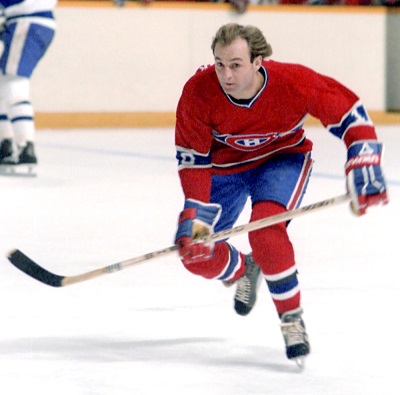
(Dennis Miles)
These players are just some of the many that have been a part of the Stars organization that did better on other teams, a list that could easily contain 15-30 more players, if not more. These are a few that I felt were very different as far as the impact they had on the team, the impact they had on other teams, and in the case of Iginla and Lafleur, were a part of an interesting technicality and are debatable as to whether they could have really been considered a Star.


[…] (PHOTO: Hooked On Hockey Magazine) […]